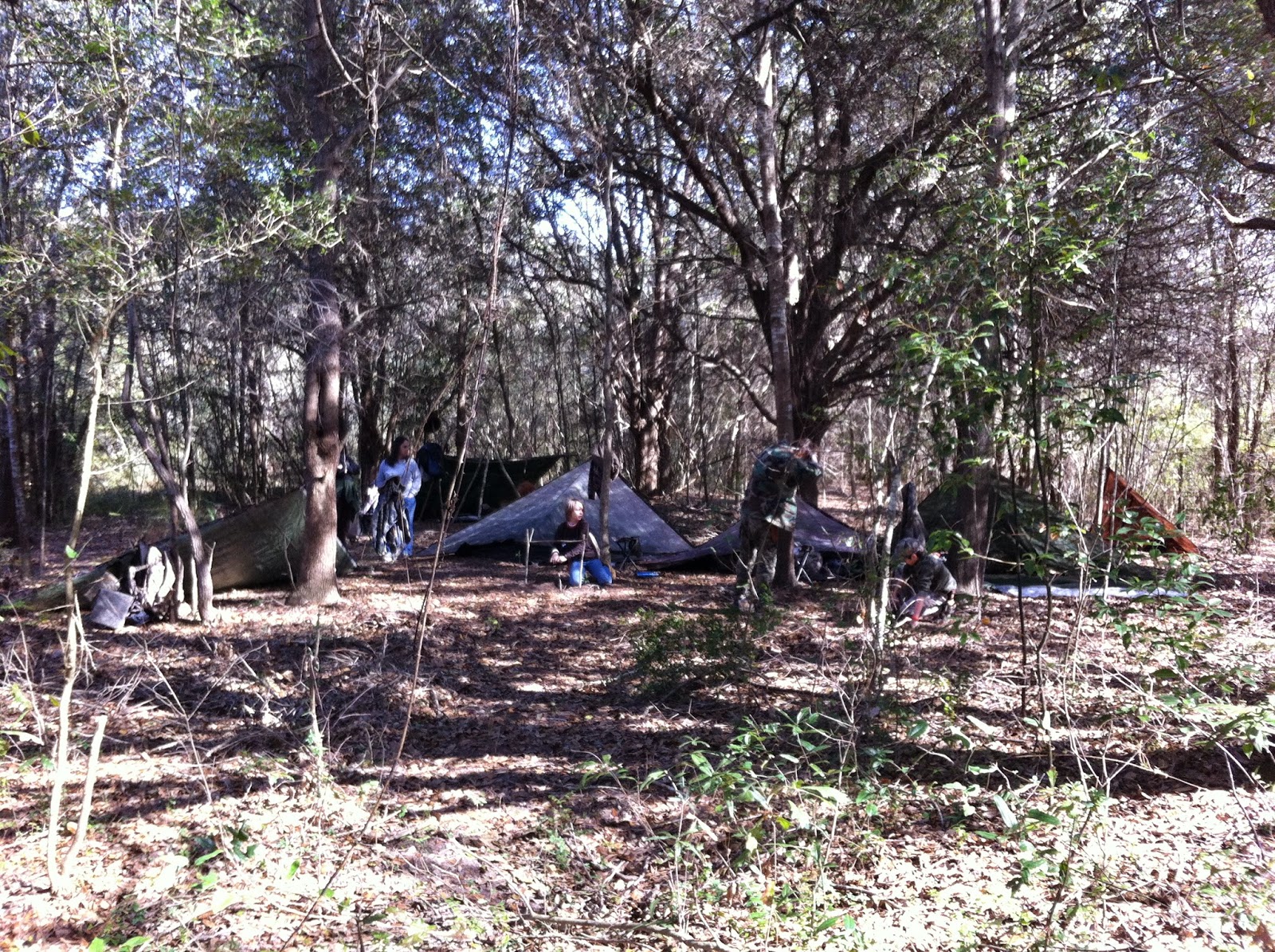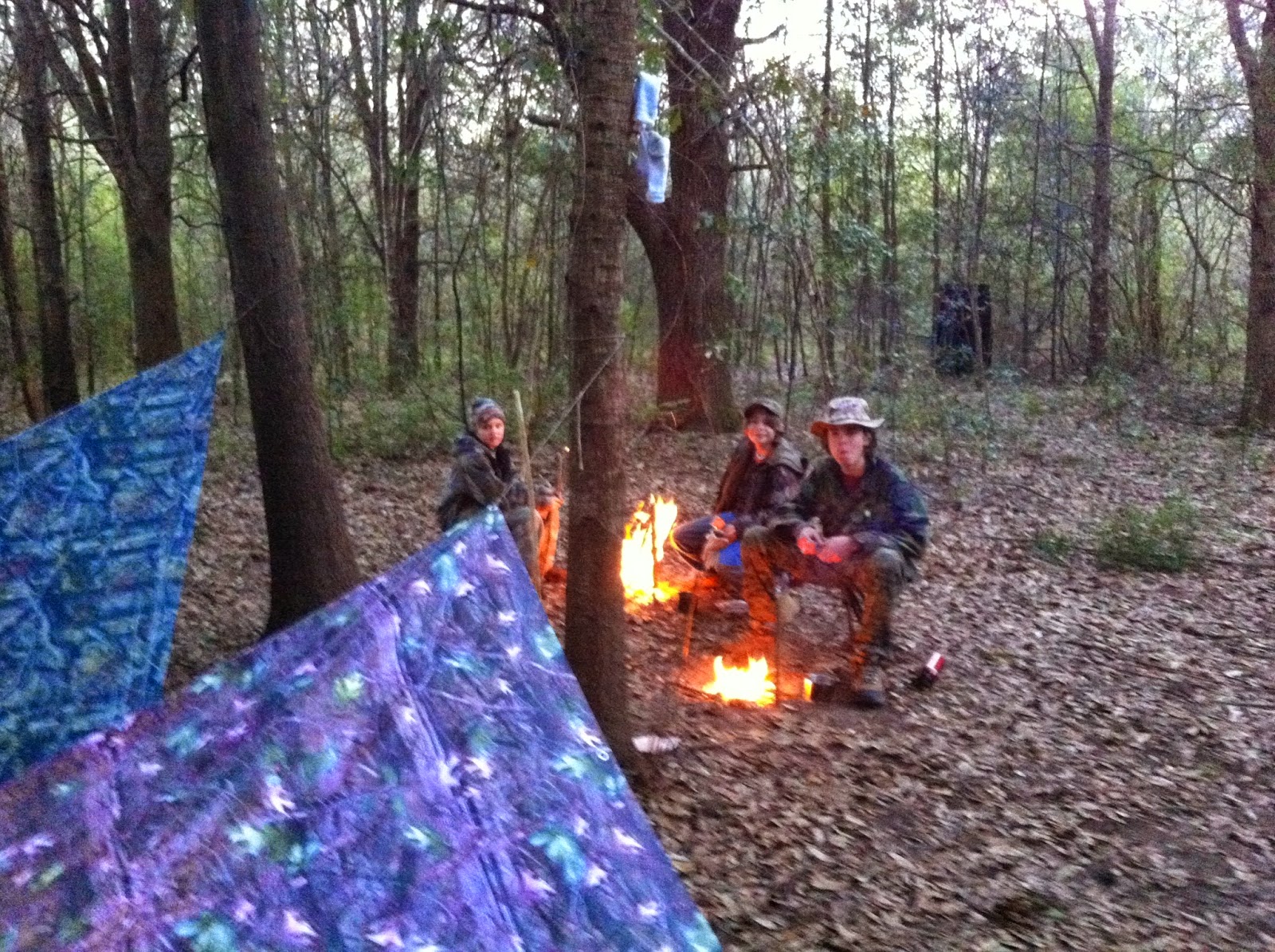Nature rules.
Safety, especially working with young woodcraft students, is always our first priority.
In the case of that planned trapping camp, what we would have had would have been a good braving the elements survival exercise. Valid enough ... a needed and extremely educational training exercise. But it would have been a really sore test of the skills levels of the group. A little passing shower on a picnic is one thing. A sub-tropical winter deluge ahead of an approaching cold front is another scenario altogether.
So we got it together on pretty short notice to do a trapping camp this past weekend, something that we needed to do within the respected time-frame perimeters allowed by the game regulations. I had already scouted out a few good set locations that offered the potential for catching something overnight.
Not only would the class be learning something new. The outing presented an opportunity for the class to practice already learned woodcraft skills in a woodland environment. It also provided an opportunity for me to observe and study on their personal progress and development. I observe their ability to perform efficiently and effectively the basic skills and, at this point, pretty much leave them alone to go about practicing those tasks. Those, for the most part, are simple skills.
Basic skills areas where they are having some difficulty, if they will pause and take time to think about what they are doing … if they will remember what they have been taught … if they will think through their own past successes and think through the steps that assured those successes … and practice … they can accomplish them on their own and garner deeper levels of personal confidence – levels that are not achieved if the challenge is averted by intervention.
Weaknesses are thereby developed into strengths.
Practice is the key.
Therein lies success.
Always.
There is something else beyond those sets of skills that I am observing.
It has to do with being interested in and adapting to nature and her natural surroundings. It has to do with their awareness of their surroundings … not only the few hazards to be encountered in a woodland but also the myriad of natural sights, sounds, and smells unnoticed by most people but offered to all people. It has to do with transition and adaptability. It has to do with discovering and embracing a oneness with and appreciation of the natural environment rather than living against it … surviving against it … as though it is some kind of a constant foe to be conquered at all cost.
A lot of people are learning skills these days. That is a good thing. People need to be learning these things. But honestly transitioning? There is not much of that, at least in my observation, going on. It is a life changing transition … a way of life transition … that is more caught than taught.
It was a great weekend for a camp. Any kind of camp.
We walked in at noon on Saturday and had plenty of time to casually go about setting up. There was no urgency. The weather was ideal.
I took time to make myself a cup of tea then come mid-afternoon I took the guys out to make three trap sets – (1) A baited PVC pipe set, (2) A flat-set in front of an active den, (3) A baited dog-proof.
My main goal was the actual demonstration of making these particular sets with a particular target animal in mind.
Coon. Pound for pound? I am of the opinion that it is the meanest critter walking the woods.
They were all three made on good locations with plenty of potential for catching ole bandit. We would know in the morning what we had to deal with. If one caught something we would have a nice block of instruction to present about dealing with a catch in a trap. Then further instruction on how to deal with the catch once we got it back to camp. One catch would make for plenty of demonstration.
Three? That would make for a good bit more work. Especially with rain in the forecast for late morning.
It was not, for me, startling or frightening … all the happy howling and yipping that pack of coyotes did when they got started about a hundred yards or so from our little hilltop tarp camp. It was musical with a bit of an eeriness to it. I knew they had been frequenting the area. Folks around have heard them. I have seen their tracks and scat. One of them is quite large for a coyote. A couple of medium sized. A few smaller ones. I was hoping they would run through that bottom overnight and make a little noise. I always enjoy the sounds of coyotes in the night. They came by and cut loose at 3:30. It made for a short night of sleep for some of the guys that straight away got up and got a fire going to keep the wild world out of the camp.
 Predawn in the woods. That bite of chill in the air. A nice bed of coals from the night fire stirred and glowing red, some tinder and kindling added, and the resulting small flame that soon turns into a good warming fire that chases away the chill. The earliest signs of daybreak followed not long after by the first chirp of an early bird.
Predawn in the woods. That bite of chill in the air. A nice bed of coals from the night fire stirred and glowing red, some tinder and kindling added, and the resulting small flame that soon turns into a good warming fire that chases away the chill. The earliest signs of daybreak followed not long after by the first chirp of an early bird.There is a solitude, a peacefulness, about it that is almost mystical … an experience that has no equal … vicarious, counterpart, or otherwise. This experience is the Real McCoy.
Coffee.
Breakfast.
The traps were waiting for us.
I had a little group talk with the guys and explained to them that we needed to be quiet as we went about this chore. If something was caught and upset we did not want to do anything to excite or alarm the animal as we walked in and approached it. We would check the traps in the order that we set them … check the line.
The guys were excited and anxious. I was too. That’s one of the things about trapping. You simply do not know what you will discover when you check the traps. It might be something you set for. It might be something you would rather not to have to deal with. It might be the critters were smarter than you and figured a way around your traps. Coons have been known to dig traps up and move them out of their way. It might be nothing at all and no sign of anything being there. You just don’t know until you get to the set. Then you know.
No catches. The 3rd trap, the dog proof, had a visitor during the night. It helped itself to a good few tastes of the bait but stopped helping itself to an easy meal just short of the trigger.
Finding empty traps still provided an opportunity for a brief block of instruction.
I explained to the guys that despite our best efforts, ultimately catching depends upon the animal. We do our best. We hope to catch. The rest is up to them. I explained to them that all three of the sets were good sets that would catch. Maybe not the first night. Maybe not the second. It might be the third night. Our responsibility was to keep checking them every 24 hours. It is both ethical and legal. I summed up our little impromptu “real time” meet-the-need block of instruction saying that if we were in a genuine survival situation we’d better get started digging for roots and grubs if we were going to eat.




